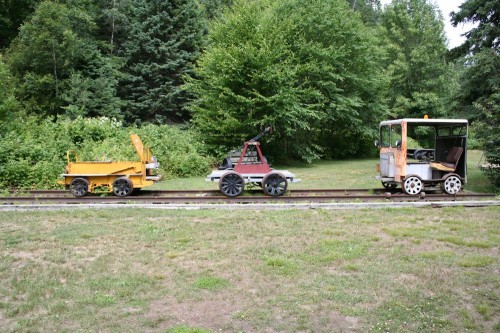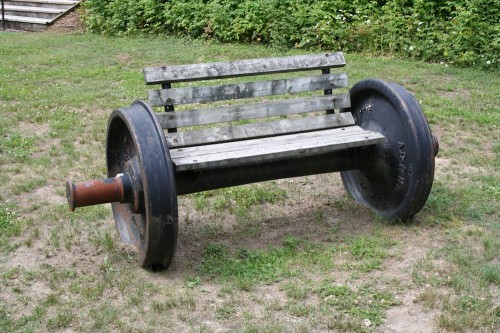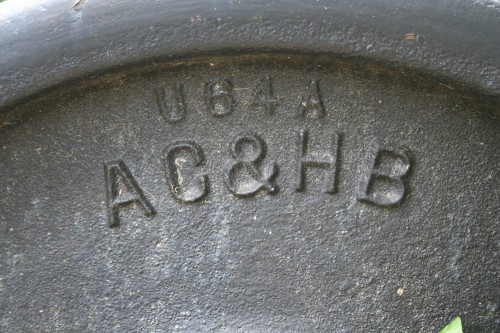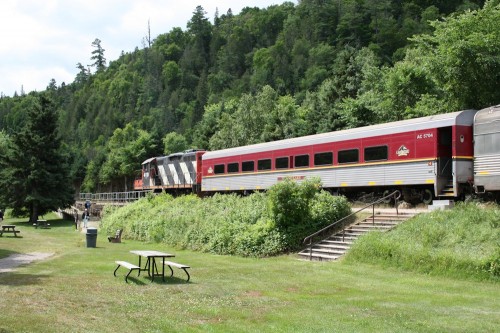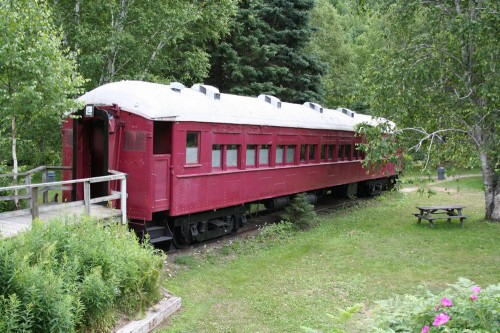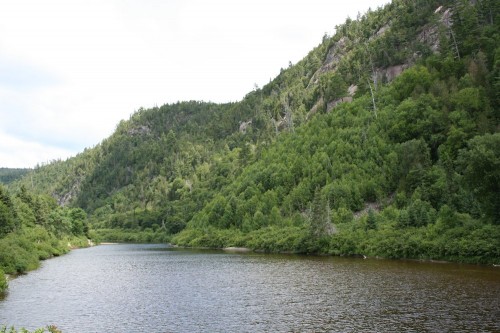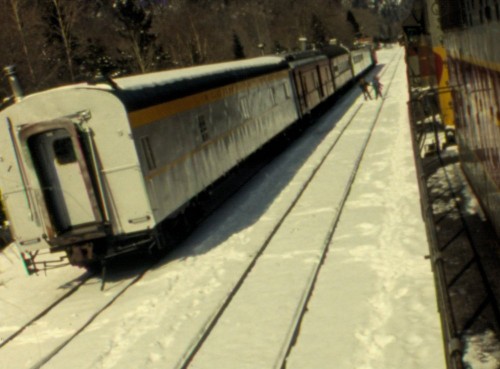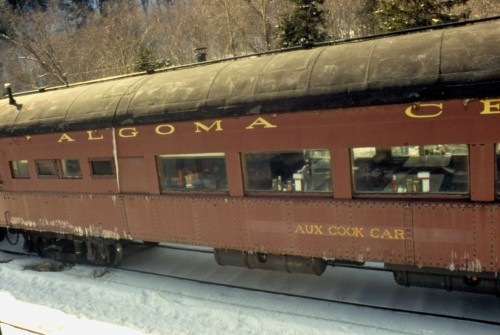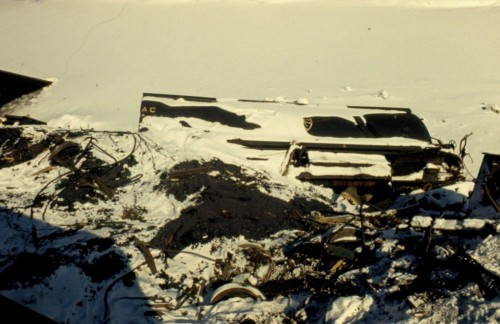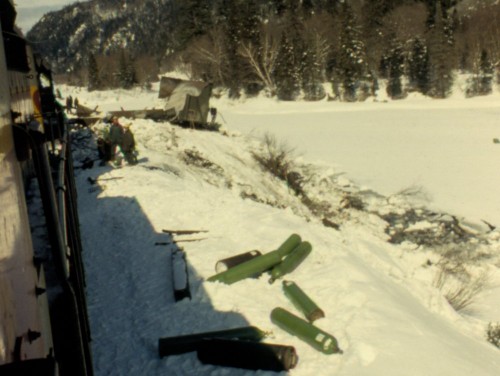At the beginning of this week I just returned from another week long vacation north of Lake Huron, visting the former Algoma Central and the Huron Central and Ontario Northland railways.
Having previously ridden the Tour of the Line last October, on Monday July 28th, I had a ticket booked to ride the Agawa Canyon Tour Train. The tickets are booked over the phone (which the helpful ACR staff make quite easy – and it’s nice to hear them answer the phone as “Algoma Central Railway”) and can be picked up at the station the morning of the departure. The train’s scheduled departure is at 8 AM, and tickets can be picked up at the station half an hour before the train leaves. I think I arrived there a little before 7:30 and ended up beating the line. Eventually around 7:40 or so the train pulled into the station and we were able to board.

The tour train at Sault Ste. Marie station. (This photo actually taken after the return to the Sault, when the sunlight is actually on the right side for photographs at this location.)
The train this day was a short 6 cars, including dining car 506, and one of the regular F40PHR locomotives was apparently away in Toronto for some repair work, so the engine on the south end of the train was a CN GP9Rm. The complete consist was as follows (from the north end):
CN 105 (F40PHR)
AC 5705 (Coach)
AC 5702 (Coach)
AC 5655 (Coach)
AC 5703 (Coach)
AC 506 (Dining Car)
AC 5704
CN 4110 (GP9Rm)
The train left precisely on time and we slowly rolled through the downtown, past the huge Essar Steel Algoma mill and past the sprawling CN yards and shops before finally clearing the yard limits and entering the main line north of town. Then it was off into the wilderness north of the Sault.
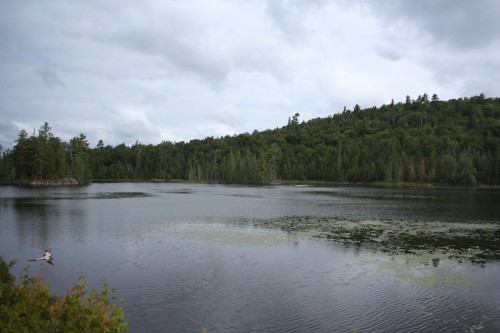
Typical lake view along the line.
Inside the coaches on the train there are video monitors throughout, which over the course of the trip play video commentary describing features of the line and its history. The video segments are apparently triggered by GPS location, so it tells you when certain notable features (like the Montreal Falls trestle for one particular example) are soon to be encountered, and also to spread out the history segments over the trip. While to an ACR historian like myself much of the information was known, I still found myself watching each segment when they played with interest, and it certainly gives an interesting background to the area you’re riding through. (Although a couple parts of the narration could use some updating as they refer to the St. Marys Paper Company as a current operation, while it has closed down a few years ago and the mill has been mostly demolished except for some of the remaining original sandstone structures dating from the 1890s mill.)
When the history segments weren’t showing on the monitors, the view was normally from a camera mounted in the front window of the lead F40PHR locomotive, giving a nice live view of the track ahead of the train. This was nice to see features ahead of the train, and was particularly interesting at one point where the train slowed because of a pair of large birds that when disturbed by the train simply flew along the tracks in front of the train for about a minute or so before finally gaining height and flying out of the way!
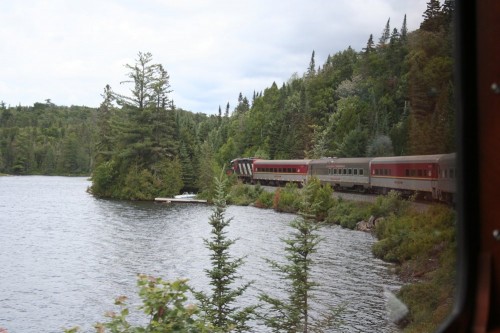
The train skirts the shore of another small northern Ontario lake.
About half an hour after departure from the Sault, the dining car opened for breakfast, for which they called the various coaches in turn. I had made sure I had something to eat at my room before heading down to the station, so I did not partake of breakfast, but later when the dining car switched over to serving lunch (for which the kitchen remained continuously open until a little after 4 PM) the on-board service staff took orders for boxed lunches from those who wished it, and these orders were taken far enough in advance of the arrival at Canyon so that you would be able to take your lunch and have a nice picnic within the park environs. I ended up ordering one of these lunches, which I believe was about $15 and contained a sandwich (on a nice large Kaiser bun, which could be one of three options: roast beef, tuna or ham & cheese – I chose the ham & cheese), bottle of water, bag of chips, brownie and a hard-boiled egg.
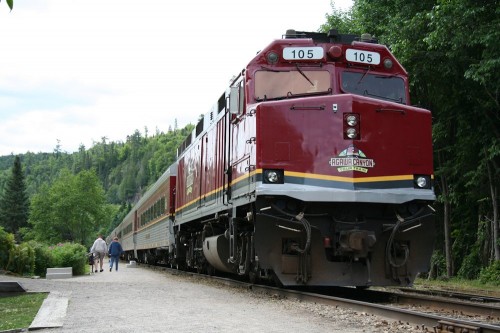
F40PHR 105 on the north end of the Agawa Canyon Tour Train at Agawa Canyon Park.
After arrival at Canyon, I wandered around the lower part of the park for a while, enjoying the area along the river, eating my lunch and taking a number of photos of the train in the park setting.
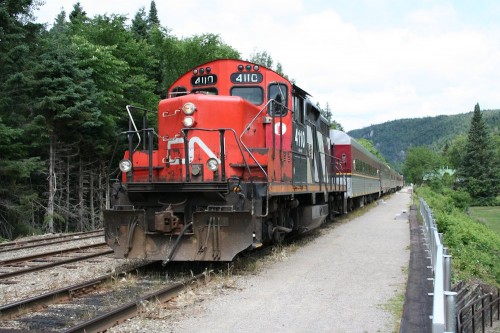
This CN GP9Rm was the southbound unit on the train. There are no turning facilities at Canyon, and the F40PHR has to remain connected to the train as it is also the on-board power source, so the tour train is operated with locomotives at each end.

Looking south from the train at Canyon.
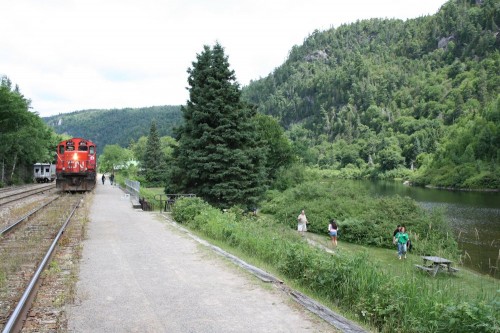
The tour train in its context at Agawa Canyon Park. The small car on the house track to the left of the train is the railway’s “camp car”, which car be rented for an overnight stay at the park.

The rocky cliffs on the other side of the river from the train’s stopping location in the park.
Ultimately, the time in the canyon came to an end, and the whistle was blown giving the 5 minute warning to return to the train for departure. The northbound passenger train to Hearst was also running that day, and I had hoped to photograph it arriving at the south end of Canyon siding, unfortunately it did not end up arriving until after our train had reboarded, and we rolled slowly to the south switch to meet the regular train there, heading south as soon as it had cleared into the siding. So I was only able to see the train from the windows of my coach as it passed by on the adjacent track, and no photos. So that was my disappointment on the trip, from a railfan’s perspective, but the actual ride to and from the Canyon was relaxing and enjoyable, as I alternately read my book or watched the northern Ontario scenery with it’s unending forest dotted with rocky hills and myriad small lakes roll by outside.
Our return time to the Sault was approximately 5:30 PM, and with the sun now in the perfect position for taking photographs at the station, I photographed the train as the unboarding completed and the train pulled out of the station to head back to the yard for servicing, cleaning and overnight parking until the next day’s train. Once the train departed the station, I wandered past the Huron Central yard to photograph some of the pulpwood flatcars around there and then headed off to find some supper, a nice day of train riding completed.


